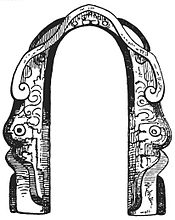bleness, ended in an established principle of the mythology of a powerful and even civilized Empire.
*******
Let us now proceed to consider the manner in which these sacrifices were conducted.
The usual number of priests required at the altar was six, one of whom acted as Sacrificer and the others as his assistants. The Chief of these, whose office and dignity were preeminent, assumed at every sacrifice the name of the deity to whom the oblation was made.
His dress was a red habit, like the Roman scapulary, fringed with cotton; his head was bound with a crown of green and yellow feathers; his ears were adorned with emeralds, and from his lips depended a turquoise. The other ministers at the rite were clad in white, embroidered with black; their locks bound up, their heads covered with leather thongs, their foreheads filleted with slips of paper of various colors, and their bodies dyed entirely black.
They dressed the victim in the insignia of the god to whom he was to be offered; adored him as they would have adored the divinity himself; and bore him around the city asking alms for the temple. He was then carried to the top of the temple and extended upon the stone of sacrifice. Four of the priests held his limbs, and another kept his head or neck firm with a yoke, an original of which is preserved in the Museum, and is here represented.

sacrificial yoke.
